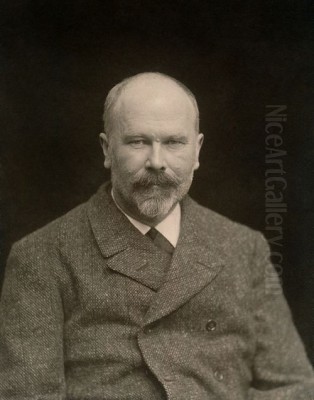
Michael Peter Ancher stands as a monumental figure in the history of Danish art. Born in 1849 on the remote island of Bornholm, he rose to become one of the most celebrated painters of his generation, inextricably linked with the unique artists' colony at Skagen. His powerful depictions of fishermen, dramatic seascapes, and the everyday life of this coastal community cemented his place as a master of Realism, capturing both the heroism and the harsh realities of life at Denmark's northernmost tip. Ancher's work bridged the academic traditions he was trained in with the burgeoning Naturalism and observational honesty that defined the Skagen Painters.
Early Life and Artistic Awakening
Michael Ancher was born in Rutsker, on the island of Bornholm, to Hans Michael Ancher, a local merchant, and Ellen Elisabeth Munch. His early life was marked by a move away from his birthplace, eventually leading him towards an artistic path. In 1865, he began an apprenticeship at the Kalø Manor east of Aarhus, but his artistic inclinations soon drew him towards formal training.
He sought instruction at C.V. Nielsen's art school in Copenhagen in 1871, a preparatory step before enrolling at the prestigious Royal Danish Academy of Fine Arts (Det Kongelige Danske Kunstakademi) later that same year. While at the Academy, he studied under figures like the historical painter Wilhelm Marstrand and the neoclassical artist Jørgen Roed, absorbing the principles of academic composition and draughtsmanship. However, Ancher, perhaps sensing a different calling or finding the academic constraints limiting, left the Academy in 1875 without completing his studies. This departure marked a turn towards a more experiential and observational approach to art.
The Lure of Skagen
A pivotal moment in Ancher's life and career occurred in 1874, even before he left the Academy, when he made his first visit to Skagen. This small fishing village, located at the windswept junction of the Skagerrak and Kattegat seas, possessed a unique character – dramatic landscapes, a resilient community dependent on the sea, and, crucially for artists, an extraordinary quality of light. The raw beauty and the inherent drama of the fishermen's lives immediately captivated Ancher.
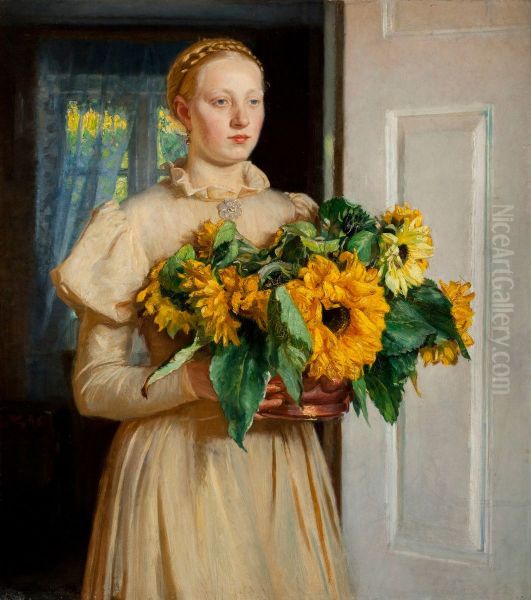
Skagen was beginning to attract a diverse group of artists and writers drawn to its authentic atmosphere and isolation from the urban centers. Ancher quickly found himself drawn into this nascent community. He returned year after year, spending summers painting the local fishermen, their boats, the dunes, and the sea. The subjects he found there – the daily toil, the camaraderie, the constant battle against the elements – would become the bedrock of his artistic output for the rest of his life.
The Skagen Painters: A Community of Artists
Michael Ancher became a central figure in the group that would become known as the Skagen Painters (Skagensmalerne). This was not a formal school with a manifesto, but rather a colony of Scandinavian artists who gathered, primarily during the summer months, to paint in and around Skagen. They shared an interest in Realism and Naturalism, often painting en plein air (outdoors) to capture the fleeting effects of light and atmosphere accurately.
Key members of this group included Peder Severin Krøyer (often known as P.S. Krøyer), arguably the most famous of the Skagen Painters, known for his vibrant scenes of social life and beach walks. Others included the Norwegian painter Christian Krohg, who shared Ancher's interest in depicting the harsh realities of maritime life, and the Swede Oscar Björck. Danish artists like Viggo Johansen, known for his intimate interior scenes, Laurits Tuxen, famous for his royal portraits and depictions of Skagen life, Carl Locher, a marine painter, and Thorvald Niss were also integral parts of the colony. The writer and sometimes painter Holger Drachmann was another prominent figure associated with the group. Karl Madsen, an artist and later influential art critic and museum director, was also a close associate from the early days.
These artists influenced and supported each other, sharing techniques and subjects, though each maintained a distinct style. They were united by a desire to break away from the perceived artificiality of academic painting and to depict the world around them with honesty and directness. Ancher, with his focus on the local fishing population, became the quintessential painter of Skagen's soul.
Marriage and Partnership: Michael and Anna Ancher
Ancher's connection to Skagen deepened profoundly when he met Anna Brøndum, the daughter of the local innkeeper whose establishment, Brøndums Hotel, served as a central meeting point for the visiting artists. Anna (1859-1935) was a talented artist in her own right, having received training in Copenhagen and later in Paris. They married in 1880, forming one of the most famous artistic couples in Scandinavian art history.
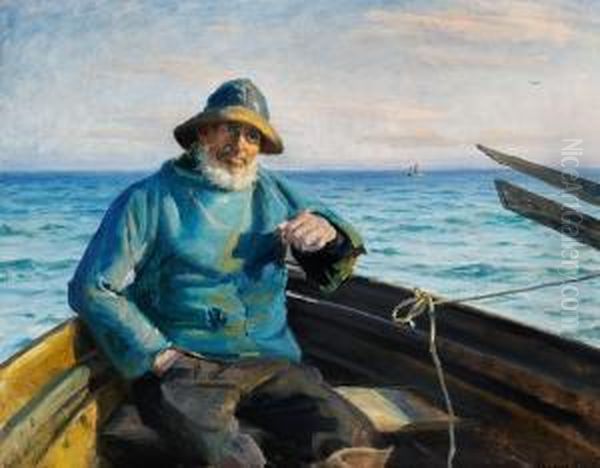
Their marriage was a partnership both personally and, to some extent, artistically. While they maintained distinct styles – Michael rooted in a robust Realism with an emphasis on monumental figures and narrative, Anna developing a more Impressionist-influenced style focused on light, color, and intimate domestic scenes – they shared a deep commitment to their art and to Skagen. They purchased a house in Skagen in 1884, now known as Anchers Hus, which became a hub for the artistic community.
Evidence of their close bond and mutual respect can be seen in works like Michael's portrait My Wife Anna (1883) and the jointly credited painting Assessing a Day's Work (1883), which depicts Anna showing Michael her sketches. Such explicit collaboration was unusual for the time. An anecdote, however, highlights the differing social norms: a painting Michael made of Anna while she was pregnant, featuring a dog near her belly, reportedly caused some consternation among contemporaries who found it improper. This incident perhaps reflects Michael's unflinching realism extending even to intimate family life.
Their only child, Helga Ancher, was born in 1883. She also became a painter. After her parents' deaths, Helga ensured their home and its contents remained intact. Following her own death in 1964, Anchers Hus was opened as a museum in 1967, offering a unique glimpse into the lives and working environment of Michael and Anna Ancher and the Skagen Painters.
Artistic Style: Heroic Realism
Michael Ancher's artistic style is firmly rooted in Realism, but it is a Realism infused with a sense of drama and monumentality. He combined the compositional skills learned at the Academy – careful arrangement of figures, clear narrative structure – with the Naturalist commitment to depicting subjects truthfully and observing the effects of light and color accurately.
His primary subjects were the fishermen of Skagen. He portrayed them not merely as picturesque figures, but as heroes engaged in a constant, often perilous, struggle with the sea. His paintings often depict moments of high drama: rescues at sea, boats battling storms, the grim aftermath of drownings. He rendered these scenes with meticulous detail, capturing the textures of worn clothing, weathered faces, ropes, and wooden boats.
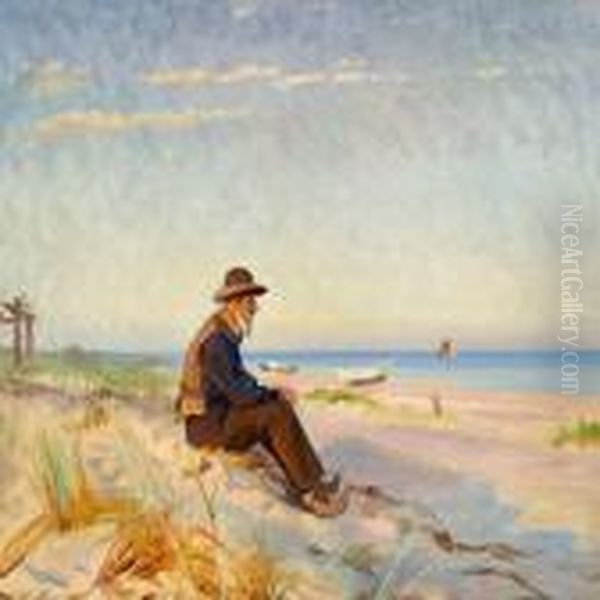
Ancher had a remarkable ability to convey the weight and solidity of his figures. They possess a physical presence and dignity, even in moments of hardship or grief. He often used strong contrasts of light and shadow to heighten the drama and focus attention on the human element within the vastness of nature. While associated with the plein air practices of the Skagen group, many of his large, complex figure compositions were likely developed through extensive sketching and studio work, combining outdoor observation with careful construction.
Compared to his wife Anna or P.S. Krøyer, Michael's palette was often more subdued, favoring earthy tones and the blues and greys of the sea and sky, though he could masterfully capture the unique Skagen light. His approach remained largely consistent throughout his career, solidifying his reputation as the great chronicler of the fishermen's saga. He also painted portraits and genre scenes, but his most powerful and enduring works are those centered on the maritime life of Skagen.
Major Works: Narratives of the Sea
Michael Ancher's oeuvre includes several iconic paintings that define his contribution to Danish art. These works often tell compelling stories of bravery, loss, and community.
Will He Weather the Point? (1879, Statens Museum for Kunst, Copenhagen): One of his early breakthroughs, this painting depicts a group of fishermen and their families anxiously watching a boat struggling against rough seas near the Skagen headland. The tension is palpable, conveyed through the concerned expressions and postures of the figures huddled against the wind. It established Ancher's focus on the human drama inherent in the fishermen's lives.
The Lifeboat is Carried Through The Dunes (1883, Statens Museum for Kunst, Copenhagen): Perhaps Ancher's most famous work, this large canvas presents a heroic scene. A team of determined fishermen hauls the heavy lifeboat across the sandy dunes towards the stormy sea, ready for a rescue mission. The painting is celebrated for its dynamic composition, detailed realism, and its powerful portrayal of collective effort and courage in the face of danger. It exemplifies Ancher's ability to create monumental figurative art based on contemporary life.
The Crew Are Saved (1894): This work often serves as a companion piece or thematic continuation of the lifeboat narrative. It depicts the aftermath of a successful rescue, showing the exhausted but relieved crew members brought safely ashore. It continues the theme of heroism and community solidarity.
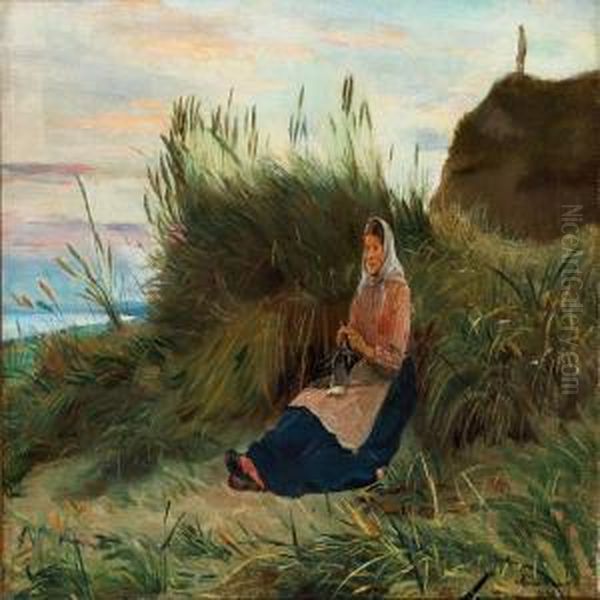
The Drowning Man (or The Drowned Fisherman) (1896, Skagens Museum): This somber and moving painting depicts the tragic discovery of a drowned fisherman washed ashore. It is believed to portray the recovery of the heroic rescuer Lars Kruse, who himself drowned in 1894. The work is a stark reminder of the ever-present dangers faced by the Skagen community. Its realism is unflinching, focusing on the grief and solemnity of the figures gathered around the body. It is considered one of his most profound and emotionally resonant works.
A Baptism (date varies, likely c. 1883-1888, Skagens Museum): This large painting depicts a christening ceremony taking place within the Skagen church. It showcases Ancher's skill in handling complex multi-figure compositions and capturing a significant community ritual. It combines portraiture with genre painting, documenting the faces and customs of the Skagen people.
Other notable works include portraits like Girl with Sunflower (1889), genre scenes such as A Boy Feeding Ducks, and depictions of the Skagen landscape and social life, sometimes painted alongside his wife Anna or colleagues like Krøyer.
Recognition and Place in Danish Art History
Michael Ancher achieved significant recognition during his lifetime. His work was regularly exhibited at the Charlottenborg Spring Exhibition in Copenhagen, the main showcase for Danish artists. He received the prestigious Eckersberg Medal in 1889, awarded by the Royal Danish Academy of Fine Arts for outstanding artistic achievement. In 1894, he was further honored by being made a Knight of the Order of the Dannebrog.
His status in Danish art history is secure and significant. He is considered one of the leading figures of the 'Modern Breakthrough' (Det Moderne Gennembrud) in Danish painting, a period characterized by a shift towards Realism and Naturalism and an engagement with contemporary social themes. While artists like P.S. Krøyer might be better known internationally for depicting the brighter, more social side of Skagen life, Ancher is revered for his profound and empathetic portrayal of the fishermen's world.
He successfully synthesized the formal training of the Academy with the direct observation and modern sensibilities of the Skagen Painters. His focus on the heroic struggles of ordinary working people aligns him with broader European Realist trends, exemplified by artists like Jean-François Millet and Gustave Courbet in France, though Ancher's work retains a distinctly Scandinavian character.
His influence extended through his role as a central, respected figure within the Skagen colony and his consistent dedication to his chosen subject matter. Along with Anna Ancher, P.S. Krøyer, Laurits Tuxen, Viggo Johansen, and Christian Krohg, Michael Ancher defined the artistic identity of Skagen. His work provided a powerful visual record of a specific time, place, and way of life that was already beginning to change even during his lifetime.
Later Life and Enduring Legacy
Michael Ancher continued to live and work in Skagen until his death in 1927. He remained an active member of the community and a respected elder figure among the artists who continued to visit Skagen, even as artistic styles began to shift towards Modernism. His dedication to his core themes – the sea, the fishermen, the Skagen landscape – never wavered.
His legacy is multi-faceted. Artistically, he left behind a powerful body of work that captures the essence of Skagen life with unparalleled authenticity and dramatic force. His paintings are highlights of major Danish museum collections, particularly the National Gallery of Denmark (Statens Museum for Kunst) and the Skagens Museum, which holds the most extensive collection of works by the Skagen Painters.
Culturally, Michael and Anna Ancher, through their home and their art, helped shape the identity of Skagen as a place of artistic significance. Anchers Hus, preserved as they left it, stands as a testament to their lives and the era of the Skagen Painters. It allows visitors to step back in time and experience the environment where so many important works of Danish art were created.
Michael Ancher's enduring appeal lies in his ability to convey universal human themes – courage, loss, community, the struggle against nature – through the specific lens of the Skagen fishing community. He elevated the everyday lives of these ordinary people to the level of monumental art, ensuring their stories and his artistic vision continue to resonate with audiences today. He remains a cornerstone of Danish Realism and a defining painter of the Nordic landscape and its people. His work stands alongside that of other great Scandinavian painters of the era, such as Anders Zorn of Sweden and Eilif Peterssen of Norway, in capturing the spirit of their time and place.